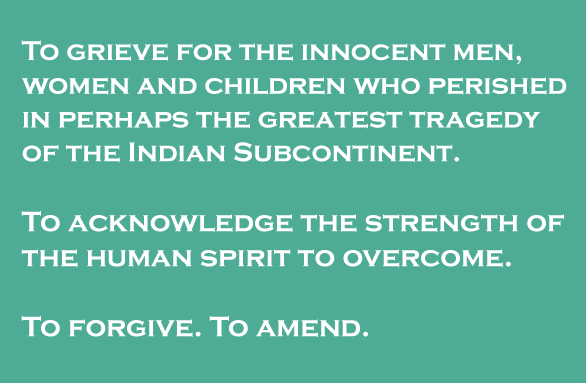
PARTITION MEMORIAL:
a possible path to forgiveness and renewal
A personal note (Rishi Raj, 2012-05-02):
I cannot say why the desire to atone for the violence of the partition keeps burning within me; my family is from Ambala, we did not suffer from it. I have spoken to many about the idea of this Memorial. Often the reaction is to leave the memories alone; they were bitter and very long ago. When pressed, then, nearly always I have heard stories of human kindness amid the fierce violence. Often the desire to be involved are expressed by the children and the grandchildren. Memories of atrocities seem to remain alive, through the generations.
I am 69 years old and have never been a leader of an organization. Still I hope, I almost feel sure, that younger people will "spring out of the ground" to help and lead and build this institution.
A couple of further (personal) thoughts: (a) The world is changed not by the rich and the powerful, but by those who have suffered and endured, (b) While there have been many tragedies on this earth, we are able to overcome them as peoples when they are followed by reconciliation. If not the wounds keep festering leading to an incessant spiral of violence. The Marshall Plan following WWII is an example of such rebuilding; the American Civil war is another. But I am not sure how the aftermath of ethnic violence can be overcome: it is not a war that ends with a clear victor and the vanquished. I do not know, but believe there must be an answer. Perhaps it is as simple as to acknowledge, and weep, to embrace and forgive. That sounds grandiose because the giving of love and affection is one of the most difficult acts for us human beings; it seems much easier to take revenge. There must be a way to quell the fire.
Please lend your hand for this cause, Rishi Raj, 2012-05-02
Mr. C. M. Bhargava's Narrative (2012-05-01):
My father worked in the Telecommunications Department of the Government and was posted near the Afghanistan border. We lived in an enclave of narrow alleys with tall buildings where the roof (the chchat) was the place to hang out. Ours was flanked by a wall with small openings crafted in the traditional Persian style. When I would play I could see the Afghan women watching me through them. I was four years old in 1947, and with my mother and sister were sent to Hoshiarpur before the partition. Here is my father's story when the separation came:
"A muslim family next door sheltered me. They kept me in a dark kothri (store room) in the back where I stayed for two months. At 4 o'clock in the morning I was brought food and allowed to move around. Once a gang came and said to my keeper that he was harboring a "kafir". He said "go ahead look for yourself". They went around the house with bayonets stabbing pillows and beds, and finally left. Eventually the government arranged a flight to lift their employees to Amritsar. My friend personally drove me under cover to the airplane."
Links to Related Sites and publications are posted here.
(i)
"Forced Migration and Ethnic Cleansing in Lahore in 1947, Some First Person Accounts," Ishtiaq Ahmed, Dept. of Political Science, Stockholm University, 15 Jun 2004. (PDF)
The accounts in this file are posted here on this website. They provide a glimpse into the cultural life in Lahore before partition.
(ii)
?